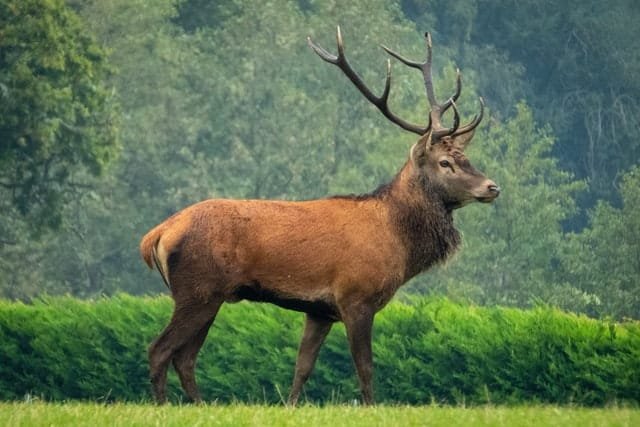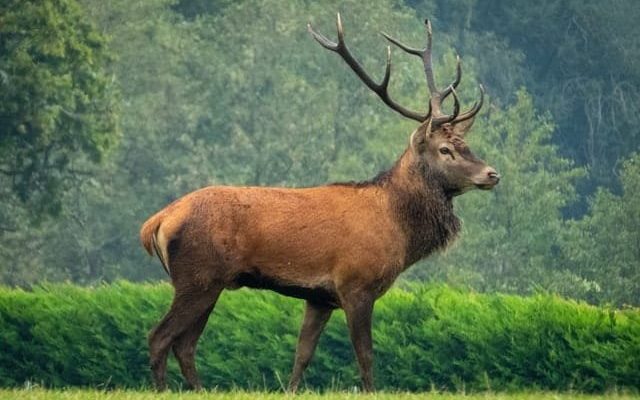
Even though red deer are not technically classified as endangered on a global level, their populations are not without challenges. Factors like habitat loss, hunting, and climate change can drastically affect their numbers in various regions. Understanding these threats helps us appreciate just how vital conservation efforts are for these animals.
What Are Red Deer?
Red deer (Cervus elaphus) are large mammals belonging to the Cervidae family. They are easily recognized by their distinctive reddish-brown coat and impressive antlers, which can span nearly four feet! These graceful animals are primarily found in forests, grasslands, and even mountainous regions across Europe, parts of Asia, and North Africa.
In essence, red deer are social creatures. They form herds, particularly during the mating season when males, known as stags, display their splendid antlers to attract females. Honestly, watching a stag bellow as it asserts its dominance is like witnessing a dramatic performance in nature.
The Conservation Status of Red Deer
Currently, red deer are classified as “Least Concern” by the International Union for Conservation of Nature (IUCN). However, this doesn’t mean they’re entirely out of the woods. You see, while some populations thrive in certain areas, others are dwindling due to various factors. In the UK, for example, red deer have been recovering since the 20th century thanks to focused conservation efforts.
In contrast, their population in some regions of Europe is declining, primarily due to human activities. Deforestation, urban development, and agriculture encroach on their habitats, limiting their space and food sources. Here’s the thing: if we don’t keep a close eye on these trends, we might find some populations slipping into more concerning statuses in the future.
Threats to Red Deer Populations
Red deer may be beautiful to look at, but they face several serious threats that can impact their survival. Let’s break it down:
- Habitat Loss: As humans expand into natural areas for farming, urban development, or logging, red deer lose their homes. This not only affects their immediate living conditions but also their food sources.
- Hunting: While regulated hunting can help manage populations, overhunting in some areas can lead to significant declines. Poaching remains a concern, driven by the illegal wildlife trade.
- Climate Change: Changing weather patterns impact food availability and habitat conditions. This can lead to malnutrition and increased vulnerability to diseases.
As you can see, it’s a tough world out there for red deer. Conservation groups and wildlife authorities are working hard to mitigate these impacts, but it requires ongoing effort and awareness.
Conservation Efforts for Red Deer
While the situation seems grim, the good news is that there are various conservation initiatives aimed at protecting red deer populations. Organizations work both locally and globally to enhance their chances of survival:
- Protected Areas: Establishing national parks and wildlife reserves provides red deer with safe habitats, away from human encroachment. These areas also help maintain biodiversity, benefiting other species as well.
- Research and Monitoring: Scientists study red deer populations and behaviors, which enables conservationists to implement informed management plans. This research highlights areas where intervention is needed.
- Community Awareness: Many groups focus on educating the public about the importance of red deer and their habitats. Engaging local communities fosters support for conservation efforts and encourages sustainable land use practices.
It’s heartening to see that by working together, humans can make a significant positive impact on red deer populations.
How You Can Help
Feeling inspired to contribute to red deer conservation? There are plenty of simple ways you can make a difference:
- Support Local Conservation Groups: Many organizations focus on preserving wildlife and their habitats. Donations or volunteering can significantly impact their efforts.
- Spread Awareness: Talk about red deer and their conservation needs with friends and family. The more people know about these majestic creatures, the more likely they are to support conservation efforts.
- Practice Responsible Recreation: If you enjoy outdoor activities like hiking or camping, stick to marked trails and follow best practices to minimize your impact on natural habitats.
Every little action counts, and as someone who appreciates nature, you can be a part of the solution.
The Future for Red Deer
Looking ahead, the future of red deer depends on our collective actions. Conservationists are hopeful, thanks to ongoing efforts to protect habitats, manage populations responsibly, and educate the public. While they may not be endangered globally right now, it’s crucial to remain vigilant.
You might have noticed that red deer embody the essence of our wild landscapes. Their presence enriches ecosystems, and losing them would be a significant loss. By safeguarding their habitats and supporting sustainable practices, we can ensure that future generations will still experience the beauty and wonder of red deer.
In conclusion, while red deer aren’t classified as endangered right now, their journey is intertwined with our choices. Whether through conservation efforts or personal actions, we can play a role in supporting these magnificent creatures and the world they inhabit. Remember, every small step we take can lead to significant change.

